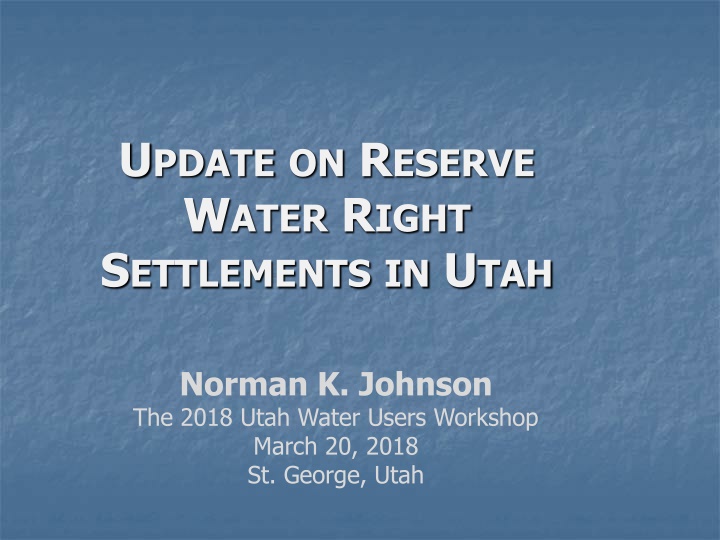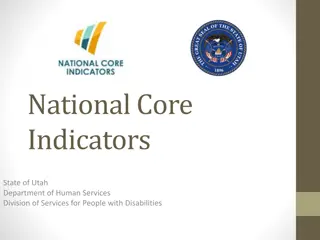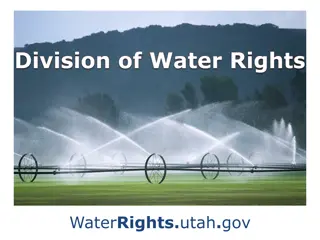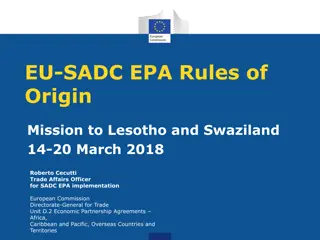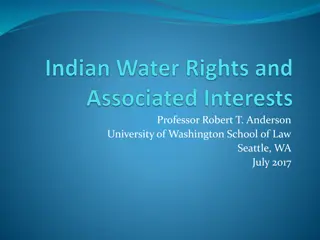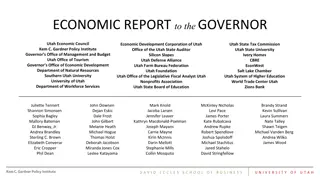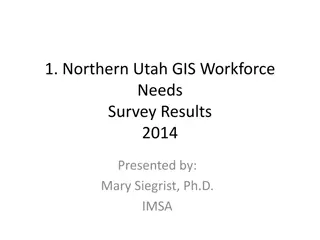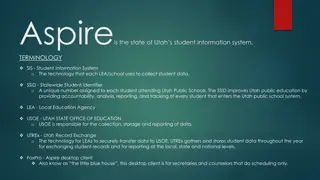Origin and Evolution of Western Water Rights in Utah
The article discusses the historical development of water rights in Utah, focusing on the principles of appropriation and prioritization in times of shortages. It highlights the constitutionally protected property rights associated with water use and the influence of federal laws and court decisions on water rights legislation in the Western United States.
Download Presentation

Please find below an Image/Link to download the presentation.
The content on the website is provided AS IS for your information and personal use only. It may not be sold, licensed, or shared on other websites without obtaining consent from the author.If you encounter any issues during the download, it is possible that the publisher has removed the file from their server.
You are allowed to download the files provided on this website for personal or commercial use, subject to the condition that they are used lawfully. All files are the property of their respective owners.
The content on the website is provided AS IS for your information and personal use only. It may not be sold, licensed, or shared on other websites without obtaining consent from the author.
E N D
Presentation Transcript
UPDATEON RESERVE WATER RIGHT SETTLEMENTSIN UTAH Norman K. Johnson The 2018 Utah Water Users Workshop March 20, 2018 St. George, Utah
J. Golden Kimball Let s not get Out of Order!
Western Water Law Origin and History In the arid West areas of water use were often located far from sources of supply Miners and irrigators built diversions and moved water to areas of need The first in time/first in right mining principles carried over to water rights The doctrine of prior appropriation of water was born (mid to late 1800s)
Western Water Law Origin and History Appropriative water rights are given a priority based on their date of creation In times of shortage, earlier priority rights are filled first to the limit of the right No sharing of shortages means some uses will be met and commerce sustained The intent was to maximize public benefit Continued beneficial use required
Western Water Law Origin and History Appropriative water rights are constitutionally protected property rights Their basis is the beneficial use of water They are defined by quantity, time, and nature of use Priority date is when beneficial use began or when an application was filed to use them They can be lost by non-use
Western Water Law Origin and History The federal government supported growth and development of this water law 1866 Mining Act and 1877 Desert Land Act required state law created water rights The U.S. Supreme Court said these acts severed the land and water estates and directed that water rights be obtained under the laws of the territories and states
Reserved Rights Doctrine Origin and History At the same time the appropriation doctrine was developing with federal approval, federal reservations of land were being made in the West Congress and the President set aside public lands for particular purposes, such as National Parks and Indian reservations, reservations, but did not create accompanying water rights
Reserved Rights Doctrine Origin and History In 1906 the U. S. sued on behalf of the Ft. Belknap Reservation Indians to secure water rights for them on the Milk River Defendant farmers/ranchers protested, saying they had valid water rights created under Montana law The suit created a genuine dilemma
Reserved Rights Doctrine Origin and History In 1908 the Supreme Court issued its Winters decision It said Congress, when it established the reservation, impliedly intended to reserve water for the Indians The reserved rights doctrine was born as an equitable, judicial response to a real and difficult controversy
Reserved Rights Doctrine Origin and History In Arizona v. California (1963) the U. S. Supreme Court said the reserved rights doctrine applies to federal reservations other than Indian reservations For Indian Reservations it said the number of practicably irrigable acres on the reservation (PIA) is used to quantify the right
Reserved Rights Doctrine Origin and History Subsequent case law further defined the reserved rights doctrine Cappaert v. U.S. (1976) the amount of water reserved is the minimum amount necessary to fulfill reservation purposes U.S. v. New Mexico (1978) primary purposes only get reserved water rights
Reserved Rights Doctrine Origin and History Recently, in Agua Caliente Band of Cahuilla Indians v. Coachella Valley Water Dist., et al., the Ninth Circuit Court of Appeals held that in the water-short Coachella Valley the United States reserved appurtenant groundwater when it created the Tribe s reservation the U.S. Supreme Court denied cert. petition This ruling will have minimal impact on Utah s efforts to negotiate settlements
Reserved Rights vs. Appropriative Water Rights Reserved water rights are important sovereign and property interests Their basis is the creation of reservations The purpose of the reservation defines their quantity (PIA for Indian reservations) Priority date is creation of the reservation They are not lost by non-use
Reserved Rights vs. Appropriative Water Rights In addition to having characteristics that conflict with appropriative water rights, the more pressing problem is that reserved water rights are un-quantified when created Given their early priority dates, they compete with and can displace State- created water rights
Reserved Water Rights vs. Appropriative Water Rights Utah, an arid state, has many federal reservations federal lands set aside for specific purposes like Indian reservations, national parks and monuments, military bases, etc. How should these rights be quantified?
Reserved Water Rights vs. Appropriative Water Rights Utah has negotiated reserved rights settlements for: Cedar Breaks, Hovenweep, Promontory Point, Rainbow Bridge, Timpanogos Cave, and Natural Bridges National Monuments Zion, Arches, Bryce Canyon National Parks Uintah Ouray Indian Reservation and Shivwits Band Reservation
Reserved Water Rights vs. Appropriative Water Rights Utah is working on settlements for: Dinosaur National Monument Capitol Reef and Canyonlands National Parks Navajo Nation Reservation Utah Legislature ratified the 1990 Ute Indian Water Compact Settlement implementation matters remain particularly in the Uintah Basin
Utah/Navajo Reserved Water Right Negotiations Navajo has substantial Winters rights Navajo s water rights must come from Utah s share of the Colorado River Utah and Navajo have worked together to resolve reserved water right issues for more than a decade A bill has been introduced in Congress
POTENTIAL LIABILITY PIA = abt. 160,000 AF of Water Depletion Expensive, Unpredict- able Litigation Non-Indian Priority Conflicts SETTLEMENT PROPOSAL 81,500 AF of Water Depletion About $200+ Million in Projects Emphasis on Drinking Water Projects Subordination to Existing Rights in local areas State Share = $8M ($2M set aside) NAVAJO NATION
BENEFITSOFA NAVAJO-UTAH SETTLEMENT AGREEMENT Quantify a Significant Reserved Water Right Improve Quality of Life for Utah Navajo People Avoid Costly Litigation and Uncertain Outcomes Provide Certainty for Water Users Navajo Nation San Juan County CUP/Wasatch Front Price River, Carbon, Emery & Grand Counties & Uintah Basin Lake Powell Pipeline Solve a Colorado River Issue http://3.bp.blogspot.com/_8306FJ3PJK8/Sp7EfFq2e7I/AAAAAAAAAAU/FTCFx6Elz2E/s400/Lineup+for+Water.jpg
UTAHS COLORADO RIVER DEPLETION BUDGET UTAH'S ALLOCATION Existing Use UNUSED ALLOCATION Future Use Ute Tribe Reserved Water Navajo Nation Reserved Water New Ag Uses New M&I Uses Lake Powell Pipeline Total Balance 1.369 MAF 1.008 MAF .361 MAF 105 KAF 81 KAF 40 KAF 29 KAF 86 KAF 341 KAF 20 KAF
GENERAL ADJUDICATION CONSIDERATIONS In Utah, general water right adjudications are pending in most of the State These adjudications, typically done in sub- basin drainages, are comprehensive and qualify for the McCarran Amendment sovereign immunity waiver They proceed slowly, both because they are complicated and because of resource considerations
GENERAL ADJUDICATION CONSIDERATIONS Once a reserved right agreement is finalized, the State Engineer will present it to the Adjudication Court in the area as a Proposed Determination (PD) The PD is the State Engineer s recommendation concerning the water rights for the reservation The PD is circulated to all parties Parties have the opportunity to object
GENERAL ADJUDICATION CONSIDERATIONS To minimize controversy, we educate parties before they receive the PD Objections must be dealt with Once all objections are resolved, the adjudication court enters an interlocutory decree The Interlocutory Decree will eventually be incorporated into a basin-wide decree
SETTLEMENTOF RESERVED WATER RIGHTS We have learned State negotiators must: Protect all federal/non-federal/tribal interests; Realize that settlements must work for all; Communicate and educate; Focus on what matters; Use technicians; Build trust; Be patient; Put things in context; and Acknowledge finality.
QUESTIONS? ~ The End ~
